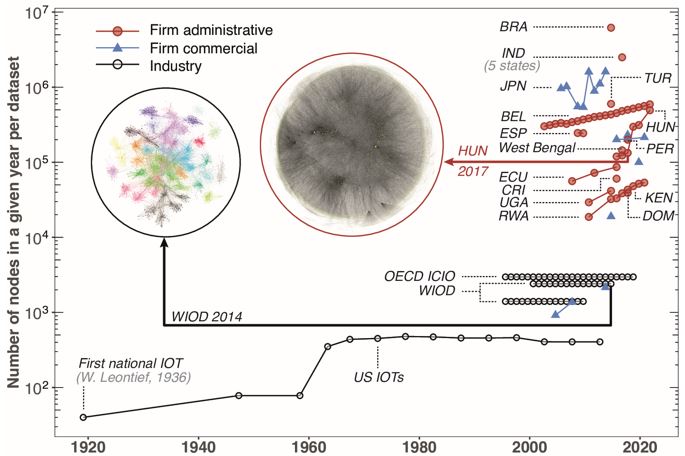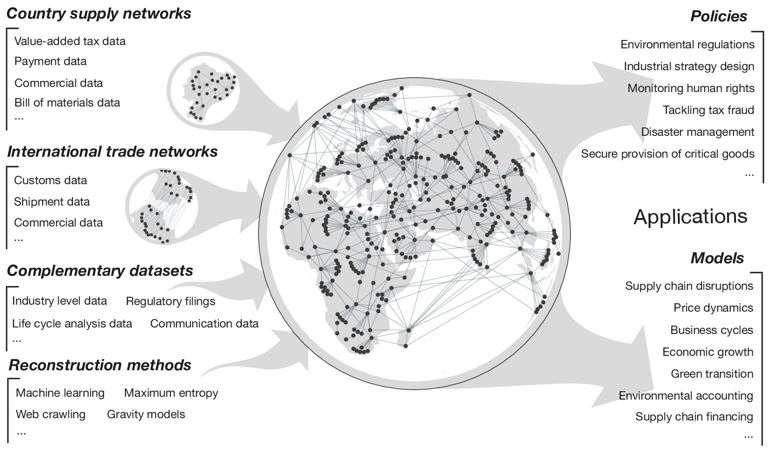

This Policy Brief is based on Pichler et al (2023), “Building an alliance to map global supply networks”, Science, 382(6668), 270-272. Acknowledgments: Figures have been created with the help of L. Yang.
In recent years, the availability of detailed supply network data has revolutionized economic analysis. These granular maps of the economy promise immense potential for addressing pivotal policy objectives such as mitigating inflation, accurately measuring indirect greenhouse gas emissions, and securing the provision of critical goods. Until now, supply networks have been predominantly mapped at the national level, highlighting the necessity for coordinated international efforts to more effectively reconstruct supply linkages crossing country borders. With the anticipated enhancement of global supply network maps in the near future, it is essential to engage in a dialogue about the responsible management and effective use of these data for the greater global benefit.
Globally, over 300 million firms are connected through a complex network of an estimated 13 billion supply links1. These connections are critical for the production, processing, and delivery of everyday items, such as food, medical supplies, as well as technologies and services that are crucial for maintaining critical infrastructures and national security. Despite their importance in ensuring the smooth functioning of the economy, our understanding of the interdependencies in these supply chains remains surprisingly limited.
In our recent publication in Science, we highlight that this knowledge gap has left us ill-prepared to respond quickly and effectively to economic challenges, as evidenced by the prolonged shortages in raw materials and critical medical supplies during the COVID-19 pandemic. For example, supply disruptions in 2021 led to an estimated 2% loss of global GDP (roughly USD 1.9 trillion), and substantially contributed to the recent surge in inflation2. To better manage and mitigate such adverse economic impact, a more detailed understanding of domestic and international supply dependencies at a granular level is essential.
Until very recently, supply network data had been limited to a few hundred firms or industries (traditional input-output tables). In the past decade, a supply network data revolution has begun, enabled by progress in several dimensions, including payment data, value-added tax (VAT) data, and methods for reconstructing missing data3. Through these efforts, the scope of supply chain data has increased by several orders of magnitude, allowing for a better picture of the real economy with unprecedented granularity. This process is still ongoing, as illustrated in Fig. 1.
Figure 1: The revolution in supply network data availability

Notes: The size of supply network data sets expanded rapidly in the last decade. For firm (industry)-level datasets, size is measured by the number of nodes, i.e., firms (economic sectors or sector-country pairs). For much of the twentieth century, national input-output tables containing up to a few hundred sectors were the most granular representation of supply networks. Recently firm-level supply network data sets have become available, containing hundreds of thousands and millions of nodes.
An important enabler of the recent surge in supply network data are country-wide administrative VAT datasets. In some countries, VAT is reported at the level of individual transactions, allowing the recovery of virtually all domestic business-to-business trades.
The potential of large-scale firm-level supply network data to boost the development of a new generation of firm-level economic models has been demonstrated in recent research. For example, based on detailed Japanese supply network data of several million firm-level supply links, it has been possible to model the indirect countrywide economic impacts of the 2011 Great East Japan Earthquake in unprecedented detail4. VAT-based firm-level supply network data has been leveraged to quantify the macroeconomic impact of individual firms in case of failure5, to detect tax fraud6 or to understand the widespread – but indirect – reliance of firms on international supply chains and imported inputs, even when the typical firm itself does not directly import7. Moreover, predictions of economic models that are based on firm-level VAT data can differ substantially from the predictions of the same models based on industry-level data.8
As recent events have shown, supply networks play a crucial role as a potential driver of inflation. Cost shocks to individual firms directly affect consumption prices as suppliers to final demand and indirectly as suppliers to firms that ultimately supply final demand. The exact impact on consumption prices and inflation depends on the production network structure and the amount of cost-price pass-through9. Firm networks define the micro origins of aggregate price fluctuations. Without detailed information on these networks, the impact of cost shocks or optimal monetary policy simply remains ephemeral.
While high-resolution maps of firm-level supply networks have recently been charted for individual economies, the international image remains highly fragmented. In our publication, we provide a blueprint of how a granular supply network map beyond country borders could be achieved within the European Union (EU).
As a first step, it is necessary to collect national firm-to-firm trades through granular VAT records, as is already done in countries like Spain, Belgium, Hungary, and Bulgaria. The next step requires connecting different countries based on trade data. The EU already integrates data on the trade of goods between member countries. Reconstructing the EU supply network at the firm level would require an extension of this data to all goods and services and to merge them with the domestic VAT data. The EU Commission’s proposal on VAT in the Digital Age (ViDA) could serve as the underlying legal framework. Doing this would result in the first comprehensive multi-country firm-level supply network, representing nearly 20% of world GDP.
The EU could further enlarge its map of supply-chain dependencies to partially include non-member countries by merging its supply network data with customs data. Customs data feature excellent coverage and detail on international firm-level trade and have already been linked with domestic VAT-based supply networks7. The supply network of EU firms and their linkages to non-EU trading partners would yield a granular view into supply chain dependencies that cover almost 40% of global trade. Missing information in these maps can be augmented by modern AI techniques10,11.
If other economic regions adopted a blueprint similar to the one outlined for the EU, these independent supply networks could be connected through customs and trade data. To achieve a coherent database of international supply linkages, harmonized standards on data collection and formatting should be developed, similar to what happened for the development of national accounts.
Figure 2: Creating and utilizing a map of the global supply network

Notes: To the left: necessary data and methodological inputs to reconstruct the global supply network. To the right: policy applications and areas of economic modeling that would improve with large-scale firm-level supply network data.
Supply networks play a key role in the propagation of economic shocks through industries, regions, and countries but are equally important for a variety of further relevant use cases (Fig. 2). For example, current approaches to assess the carbon intensity of products or indirect (Scope 3) emissions of firms build on aggregate industry data or detailed but highly incomplete data from life-cycle analysis. A granular map of underlying supply networks could substantially improve the measurement and monitoring of CO2 emissions in the economy.12
Such maps would be similarly important for effectively implementing and executing policies such as the EU Supply Chain Act, which is targeted at obliging companies to monitor environmental and social standards along their entire supply chain. However, as supply chains are intricate networks, it is almost impossible to comprehensively oversee them without granular data.
Governments could benefit substantially from an improved collection of detailed supply network data. Besides benefitting from enhanced tax compliance, such data will help identify indirect exposures to natural disasters or upstream supply chain bottlenecks for critical goods such as medical supplies. Governments could then take resilience-enhancing measures, such as incentivizing companies to diversify their suppliers.
Central banks could similarly benefit because extensive firm-level supply network data will considerably improve our understanding of inflation dynamics and how the propagation of economic shocks affects financial stability13. Central banks are already at the forefront of working with and making these data accessible for scientific economic analysis. As data availability and methodological development progress, they could integrate this knowledge into monetary policy, macro-prudential policy, and financial market supervision.
Currently, there are several independent efforts at both the national and supranational levels to chart specific parts of the global supply network. Notable examples include the EU proposal for a Directive on corporate sustainability due diligence, the U.S. Supply Chain Disruptions Task Force, and the U.K. Department of International Trade supply chains resilience framework, .
However, these maps will remain fragmented and inadequate for addressing critical societal challenges without a concerted approach. International organizations, including the International Monetary Fund, the World Bank, the OECD, the United Nations Statistics Division and Eurostat, have considerable expertise in harmonizing international datasets and should play a key role in scaling up these efforts to the international level.
Building this alliance would result in a comprehensive map of international firm-level supply connections. This map could serve as a new foundation for economic analyses and policies at both the national and international levels.
Pichler, A., Diem, C., Brintrup, A., Lafond, F., Magerman, G., Buiten, G., Choi, T.Y., Carvalho, V.M., Farmer, J.D., & Thurner, S. (2023). Building an alliance to map global supply networks. Science, 382(6668), 270-272.
O. Celasun, N.-J. H. Hansen, A. Mineshima, M. Spector, J. Zhou, Supply bottlenecks: Where, why, how much, and what next? Working Paper WP/22/31, International Monetary Fund, 17 February 2022.
A. Bacilieri, A. Borsos, P. Astudillo-Estevez, F. Lafond, Firm-level production networks: What do we (really) know? Working paper 2023-08, Institute for New Economic Thinking, University of Oxford, Oxford, May 2023.
Carvalho, V. M., Nirei, M., Saito, Y. U., & Tahbaz-Salehi, A. (2021). Supply chain disruptions: Evidence from the Great East Japan earthquake. The Quarterly Journal of Economics, 136(2), 1255-1321.
Diem, C., Borsos, A., Reisch, T., Kertész, J., & Thurner, S. (2022). Quantifying firm-level economic systemic risk from nation-wide supply networks. Scientific reports, 12(1), 7719.
Diem, C., Borsos, A., Reisch, T., Kerte sz, J., & Thurner, S. (2024). Estimating the loss of economic predictability from aggregating firm-level production networks. PNAS Nexus, in press.
Alexopoulos, A., Dellaportas, P., Gyoshev, S., Kotsogiannis, C., & Pavkov, T. (2020). Detecting network anomalies in the Value Added Taxes (VAT) system. A TARC Policy Analysis Report.
Dhyne, E., Kikkawa, A. K., Mogstad, M., & Tintelnot, F. (2021). Trade and domestic production networks. The Review of Economic Studies, 88(2), 643-668.
Duprez, C., & Magerman, G. (2018). Price updating in production networks (No. 352). NBB Working Paper.
Brintrup, A., Wichmann, P., Woodall, P., McFarlane, D., Nicks, E. and Krechel, W., 2018. Predicting hidden links in supply networks. Complexity, 2018, pp.1-12.
Mungo, L., Lafond, F., Astudillo-Estévez, P. and Farmer, J.D., 2023. Reconstructing production networks using machine learning. Journal of Economic Dynamics and Control, 148, p.104607.
Stangl, J., Borsos, A., Diem, C., Reisch, T., & Thurner, S. (2024). Reducing employment and economic output loss in rapid decarbonization scenarios using firm-level production networks. Nature Sustainability, in press.
Tabachová, Z., Diem, C., Borsos, A., Burger, C., & Thurner, S. (2023). Estimating the impact of supply chain network contagion on financial stability. arXiv:2305.04865.
See Pichler et al. (2023).
See Celasun et al. (2022).
See Bacilieri et al. (2023).
See Carvalho et al. (2021).
See Diem et al. (2022).
See Alexopoulos et al. (2020).
See Dhyne et al. (2021).
See Diem et al. (2024).
See Duprez & Magerman (2018).
See Brintrup et al. (2018).
See Mungo et el. (2023).
See Stangl et al (2024).
See Tabachová et al. (2023).